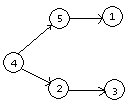poj 3687 Labeling Balls - 贪心 - 拓扑排序
Windy has N balls of distinct weights from 1 unit to N units. Now he tries to label them with 1 to N in such a way that:
- No two balls share the same label.
- The labeling satisfies several constrains like "The ball labeled with a is lighter than the one labeled with b".
Can you help windy to find a solution?
Input
The first line of input is the number of test case. The first line of each test case contains two integers, N (1 ≤ N ≤ 200) and M (0 ≤ M ≤ 40,000). The next M line each contain two integers a and b indicating the ball labeled with a must be lighter than the one labeled with b. (1 ≤ a, b ≤ N) There is a blank line before each test case.
Output
For each test case output on a single line the balls' weights from label 1 to labelN. If several solutions exist, you should output the one with the smallest weight for label 1, then with the smallest weight for label 2, then with the smallest weight for label 3 and so on... If no solution exists, output -1 instead.
Sample Input
5 4 0 4 1
1 1 4 2
1 2
2 1 4 1
2 1 4 1
3 2
Sample Output
1 2 3 4
-1
-1
2 1 3 4
1 3 2 4
题目大意 找出原图的一个拓扑序,使得1尽量靠前,2尽量靠前....(注意输出的是第i个球的重量是第几小)。无解输出-1.
我学长给出了一个正确性很显然的做法
正向建图,把当前集合中的点中最小点找出来,然后再暴力统计有多少个点指向它,那么这些点一定在它之前,就可以将原DAG分成两部分递归处理。时间复杂度O(n(n + m))
Code
还有个做法是反向建图,然后用大根堆去跑拓扑排序,最后输出的时候reverse一遍。虽然n变成了log2n,但是似乎正确性不是那么的显然。
如果解释的话可以这么想,正向建图,跑小根堆先把小的取走,保证了在大的尽量在后面,但是无法保证小的尽量在前面,比如说下面这个建出来的DAG。
 这真是一个优美的反例。
这真是一个优美的反例。
而反向建图跑大根堆,可以保证大的先被取走,自然小的就留在后面,reverse后,小的就跑到前面去了。
下面给出一个并不太严谨的证明(有问题一定要指出来)
假定存在一个更优的答案,那么第一处不相同的地方一定满足这个算法跑出来的值比这个答案大,因为前面的都相同,又因为都是1 ~ n的一个排列,那么意味着一定存在某个位置,这个答案比这个算法跑出来的值大。这意味着答案取出了比拓扑序某个时候,入度为0的点的最大值还大的数,这显然是不可能的。所以不存在更有的答案,所以这个答案就是最优的答案。
Code
/**
* poj
* Problem#3687
* Accepted
* Time:32ms
* Memory:1116k
*/
#include <iostream>
#include <cstdio>
#include <ctime>
#include <cmath>
#include <cctype>
#include <cstring>
#include <cstdlib>
#include <fstream>
#include <sstream>
#include <algorithm>
#include <map>
#include <set>
#include <stack>
#include <queue>
#include <vector>
#include <stack>
#ifndef WIN32
#define Auto "%lld"
#else
#define Auto "%I64d"
#endif
using namespace std;
typedef bool boolean;
const signed int inf = (signed)((1u << ) - );
const double eps = 1e-;
const int binary_limit = ;
#define smin(a, b) a = min(a, b)
#define smax(a, b) a = max(a, b)
#define max3(a, b, c) max(a, max(b, c))
#define min3(a, b, c) min(a, min(b, c))
template<typename T>
inline boolean readInteger(T& u){
char x;
int aFlag = ;
while(!isdigit((x = getchar())) && x != '-' && x != -);
if(x == -) {
ungetc(x, stdin);
return false;
}
if(x == '-'){
x = getchar();
aFlag = -;
}
for(u = x - ''; isdigit((x = getchar())); u = (u << ) + (u << ) + x - '');
ungetc(x, stdin);
u *= aFlag;
return true;
} ///map template starts
typedef class Edge{
public:
int end;
int next;
Edge(const int end = , const int next = -):end(end), next(next){}
}Edge; typedef class MapManager{
public:
int ce;
int *h;
vector<Edge> edge;
MapManager(){}
MapManager(int points):ce(){
h = new int[(const int)(points + )];
memset(h, -, sizeof(int) * (points + ));
}
inline void addEdge(int from, int end){
edge.push_back(Edge(end, h[from]));
h[from] = ce++;
}
inline void addDoubleEdge(int from, int end){
addEdge(from, end);
addEdge(end, from);
}
Edge& operator [] (int pos) {
return edge[pos];
}
inline void clear() {
edge.clear();
delete[] h;
}
}MapManager;
#define m_begin(g, i) (g).h[(i)]
#define m_endpos -1
///map template ends int n, m;
MapManager g;
int* dag;
int* dep; inline boolean init() {
if(!readInteger(n)) return false;
readInteger(m);
g = MapManager(n);
dag = new int[(n + )];
dep = new int[(n + )];
memset(dag, , sizeof(int) * (n + ));
for(int i = , a, b; i <= m; i++) {
readInteger(a);
readInteger(b);
g.addEdge(b, a);
dag[a]++;
}
return true;
} priority_queue<int> que;
inline void topu() {
for(int i = ; i <= n; i++)
if(!dag[i]) {
que.push(i);
}
int cnt = ;
while(!que.empty()) {
int e = que.top();
dep[e] = cnt++;
que.pop();
for(int i = m_begin(g, e); i != m_endpos; i = g[i].next) {
int& eu = g[i].end;
dag[eu]--;
if(!dag[eu])
que.push(eu);
}
}
} inline void solve() {
topu();
for(int i = ; i <= n; i++) {
if(dag[i]) {
puts("-1");
return;
}
}
for(int i = ; i <= n; i++)
printf("%d ", n - dep[i]);
putchar('\n');
} inline void clear() {
g.clear();
delete[] dep;
delete[] dag;
} int T;
int main() {
readInteger(T);
while(T--) {
init();
solve();
clear();
}
return ;
}
poj 3687 Labeling Balls - 贪心 - 拓扑排序的更多相关文章
- POJ 3687 Labeling Balls【拓扑排序 优先队列】
题意:给出n个人,m个轻重关系,求满足给出的轻重关系的并且满足编号小的尽量在前面的序列 因为输入的是a比b重,但是我们要找的是更轻的,所以需要逆向建图 逆向建图参看的这一篇http://blog.cs ...
- POJ 3687 Labeling Balls(拓扑排序)题解
Description Windy has N balls of distinct weights from 1 unit to N units. Now he tries to label them ...
- POJ 3687 Labeling Balls (top 排序)
Labeling Balls Time Limit: 1000MS Memory Limit: 65536K Total Submissions: 15792 Accepted: 4630 D ...
- POJ - 3687 Labeling Balls (拓扑)
(点击此处查看原题) 题意 此处有n盏灯,编号为1~n,每盏灯的亮度都是唯一的,且在1~n范围之间,现已知m对灯之间的关系:a b ,说明灯a的亮度比灯b小,求出每盏灯的亮度,要求字典序最小(编号小的 ...
- [ACM] POJ 3687 Labeling Balls (拓扑排序,反向生成端)
Labeling Balls Time Limit: 1000MS Memory Limit: 65536K Total Submissions: 10161 Accepted: 2810 D ...
- POJ 3687 Labeling Balls(反向拓扑+贪心思想!!!非常棒的一道题)
Labeling Balls Time Limit: 1000MS Memory Limit: 65536K Total Submissions: 16100 Accepted: 4726 D ...
- poj 3687 Labeling Balls(拓扑排序)
题目:http://poj.org/problem?id=3687题意:n个重量为1~n的球,给定一些编号间的重量比较关系,现在给每个球编号,在符合条件的前提下使得编号小的球重量小.(先保证1号球最轻 ...
- poj 3687 Labeling Balls【反向拓扑】
Labeling Balls Time Limit: 1000MS Memory Limit: 65536K Total Submissions: 12246 Accepted: 3508 D ...
- poj 3687 Labeling Balls(拓补排序)
Description Windy has N balls of distinct weights from 1 unit to N units. Now he tries to label them ...
随机推荐
- 题外话:Lua脚本语言存在的意义
纯属个人见解. 大致来说:c/c++执行效率高,游戏中一些性能敏感的复杂计算需要用c/c++来实现,防止游戏卡顿和低帧率.这些复杂计算包括战斗逻辑,复杂AI,骨骼动画蒙皮骨骼点的坐标计算等等.但c++ ...
- !! MACD战法总结
我现在只发技术,不预测大盘.其实说实话,大盘不用预测,只要按照guoweijohn战法,有买入信号就入,有卖出信号就出..你也会成为股神..不是吹牛,且听慢慢分解 股市有三种市场: 一.牛市 二.震荡 ...
- hdu3879 最大权闭合回路
题意: 有n个基站可以建立,然后m个团体会使用这些基站进行工作,地i个团体会适应Ai Bi 这两个基站, 如果建成收益Ci, 第j个基站花费Pj,求如何建立使得收益最大, 将每个团体看以一个点,然后 ...
- Java基础(basis)-----异常与错误处理
1.编译型异常和运行时异常 编译时异常是指程序正确 而由外界条件不满足而产生的异常 java 中要求必须去捕捉住这类异常 不然无法通过编译 运行时异常是指程序存在着bug 如空指针异常 数 ...
- Spark学习之路 (四)Spark的广播变量和累加器
一.概述 在spark程序中,当一个传递给Spark操作(例如map和reduce)的函数在远程节点上面运行时,Spark操作实际上操作的是这个函数所用变量的一个独立副本.这些变量会被复制到每台机器上 ...
- 对SQLite 数据库的一点点了解
SQLite,是一款轻型的数据库,是遵守ACID的关系型数据库管理系统,它包含在一个相对小的C库中.它的设计目标是嵌入式的,它占用资源非常低,在嵌入式设备中,可能只需要几百k的内存就够了. SQLit ...
- 初探AngularJs框架(一)
一.需要准备的环境 Nodejs:https://nodejs.org/en/download/ Python:https://www.python.org/downloads/release/pyt ...
- 创建一个简单的WCF程序
1.创建WCF服务库 打开VS2010,选择文件→新建→项目菜单项,在打开的新建项目对话框中,依次选择Visual C#→WCF→WCF服务库,然后输入项目名称(Name),存放位置(Location ...
- golang学习笔记8 beego参数配置 打包linux命令
golang学习笔记8 beego参数配置 打包linux命令 参数配置 - beego: 简约 & 强大并存的 Go 应用框架https://beego.me/docs/mvc/contro ...
- The Little Prince-12/12
The Little Prince-12/12 双十二,大家有没有买买买呢?宝宝双十一之后就吃土了,到现在,叶子都长出来了!!! 当你真的喜欢一个人的时候 就会想很多 会很容易办蠢事 说傻话 小王子要 ...
